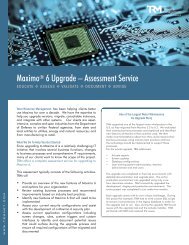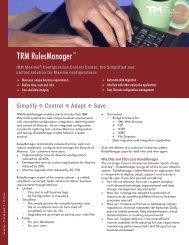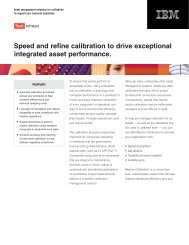NAVFAC Single Platform Maximo - Total Resource Management
NAVFAC Single Platform Maximo - Total Resource Management
NAVFAC Single Platform Maximo - Total Resource Management
Create successful ePaper yourself
Turn your PDF publications into a flip-book with our unique Google optimized e-Paper software.
Designing, engineering and implementing <strong>Single</strong><strong>Platform</strong> <strong>Maximo</strong> ® for the U.S. NavyThe Opportunity: Leverage the powerof the Internet to consolidate theNavy’s Public Works Centers (PWC)asset management and maintenancesystems in each of eight PWC locations,and then standardize and furtherconsolidate these systems to a singleenterprise asset management platform.══════════════════The Required Outcome:• <strong>Total</strong> visibility of assets,requirements, work projects andresources• Significant readiness improvement• Compliance with DoD and NMCIcertifications• Open source, pure Internetarchitecture• Ability to support more than 4,000users in 14 different time zones• Ability to manage as many as 1.3million work orders;• 250,000 purchase orders; 600,000equipment items and 98,000buildings annuallyWinning the battle required the power of the Internet, theforesight of Navy leaders, superior engineering expertise,powerful software and tremendous teamworkThe power of the Internet was there.Figuring out how to leverage it wasthe challenge. Like many largeorganizations, the Navy’s Public WorksCenters (PWCs) were dogged by disparate systems, islands of data andredundant input. A system capable of supporting concurrent use amongmultiple sites and time zones, and a myriad of project requirements andreporting standards was needed. No small order. New ground would haveto be broken. The mission included maintenance planning, work orderexecution and integration with the Navy’s financial system. It also called fora thorough assessment of assets to determine deficiencies, redundanciesand equipment condition. This was necessary to determine the extent towhich consolidation was needed, while assessing the support required forthe units covering the Navy’s war fighting capabilities. In the end, therehad to be one process, one consistent look, and one single set of rules formaintaining and supporting the Navy’s facilities and assets.www.trmnet.comEnterprise Asset <strong>Management</strong> standardization<strong>Total</strong> <strong>Resource</strong> <strong>Management</strong> (TRM) started working with the Navy in 1996. Infact, it was TRM that proposed a best-in-class enterprise asset management(EAM) software solution – <strong>Maximo</strong> developed by MRO Software. TRM’s firstassignment was to standardize the use of <strong>Maximo</strong> at each of the PWCs.These centers were responsible for maintaining nearly 60% of the Navy’sfacilities with a combined annual facilities support operating budget ofapproximately $1.6 billion.Initially, the goal was to engineer nine (later reduced to eight) site-specific,similarly configured PWC systems, where each PWC ran an independentinstance of <strong>Maximo</strong> that communicated with a local database in a clientserver architecture. The Navy specialists, with the help of TRM projectmanagers and technical services staff, standardized all the PWCs to onesystem, creating the ability to assess business processes and organizeand structure <strong>Maximo</strong> in a similar manner for each location. This move to<strong>Maximo</strong> resulted in the reduction of nearly 300 separate systems to eight<strong>Maximo</strong> operations.
It was when TRM assisted the Navy in the development of“PWC Corporate Core Standards” to define the businessprocesses, tools and configuration management policiesrequired to implement and maintain the core standardthat it became obvious that another level of consolidationwas necessary. Ultimately this resulted in <strong>Single</strong> <strong>Platform</strong><strong>Maximo</strong> (SPM).Like most businesses during this time, the Navy leaderswere being challenged to improve operational efficienciesand reduce costs. The Internet was proving to be a wayto offer flexibility and scalability. In the fall of 2002, theNaval Facilities Engineering Command (<strong>NAVFAC</strong>) teamwas directed to accelerate the move to web technology.The PWC <strong>Maximo</strong> community was challenged to gobeyond “separate but equal” standardization to developa single configuration that operated at a single host sitewith the ability to view facility maintenance managementdata across the entire Navy.The evolution of SPMTRM engineers and specialists worked closely with the<strong>NAVFAC</strong> team to develop the <strong>Single</strong> <strong>Platform</strong> <strong>Maximo</strong>(SPM) solution. The goal: to further standardize,consolidate and streamline EAM systems associated withall of the Navy’s PWCs to one, single EAM platform withmultiple entry points.The technical and organizational challenges of SPM aregreat. The team quickly realized that the tradeoffs ofbeing able to view asset information across the entireorganization, from any browser, involved complexconfiguration considerations – including business rules,screens and interfaces to other applications. Because ofthe complex nature of the project and the vast numberof concurrent activities, the SPM-integrated productteam recommended a structured project managementapproach. Phases included planning, requirements,design and installation/acceptance. “TRM was able toquickly shift focus to meet the dynamic nature of theNavy’s PWC world. In-depth analysis and problemsolvingoccurred at every step, especially as we dealtwith emerging requirements,” said Ken Kelley, <strong>NAVFAC</strong>Assistant CIO for PWCs.Two pilot sites were designated, PWC Washington andPWC Norfolk. The functionality and application of SPMwas to be completely defined by the time the first two pilotsites were in full production. After both pilot sites go liveand Initial Operating Capability (IOC) is achieved, therest of the PWCs will phase into SPM, two sites at a time.Due to its close proximity to <strong>NAVFAC</strong> headquarters andits organizational and functional complexity, Washingtonwas the first site to go live. “My hat’s off to the TRMTeam,” said John Hopkins, PWC Washington <strong>Maximo</strong>project manager, when the Washington PWC went livein August 2003. “I was impressed with TRM’s problemresolution process during the go-live week, and howwell activities and processes were organized.” Norfolk,the Navy’s largest PWC, is expected to go live with SPMin July 2004. Additional load testing and continualapplication monitoring will precede each additional PWCas it is converted to the new SPM platform.“<strong>Single</strong> <strong>Platform</strong> <strong>Maximo</strong> is historic,” says Don Omura,vice president of Pacific operations for TRM. “It leveragesweb technology to simultaneously standardize businesspractices, consolidate facilities data and reduce ITdevelopment and operating expenses. And, while this hasbeen a major technical challenge, the job of managingchanges to organizational and business processes hasbeen equally important. We’re not just moving <strong>Maximo</strong>to the web; we’re moving people and organizations to anenterprise-level set of standardized business processes.This calls for major adjustments on all fronts.”The difference is real at PWC Washington. Usersdoubleclick their Internet browser and access a new,industrial strength web application hosted at a centrallocation 2,700 miles away, in Port Hueneme, CA atthe <strong>NAVFAC</strong> Information Technology Center (NITC).Functionality and integration, including customer (workorder) management, handheld devices, financials,facilities condition assessment and readiness, purchasingand reporting, are being migrated to one application,one data base, one set of standardized businessprocesses. The bottom line – one view of the facilitiesmanagement data across the entire corporation.Virtual teamingA project of this scope, on technology’s leading edge,calls for a skilled, flexible team that can vary notonly in size but also in skill mix. TRM worked with theNavy’s Public Works Field Support Office, or PWFSO,to put together a truly “virtual team.” Both informationtechnology and telecommunications capabilities arecombining with tremendous human talent to makecertain the expertise that’s needed is available anytime,anywhere.The virtual teams have worked to finalize the functionaland data requirements and design a system architecturethat supports the <strong>Maximo</strong> web technology, complies withNavy IT security rules, supports 4,000 users and providesenough redundancy to ensure continuity of operations24/7.This virtual teaming method uses collaborative toolsfor communication and configuration management tomaintain the integrity of the development code. TRM hasdeveloped a center of excellence around applicationbenchmarking and monitoring as part of its standardsystem engineering procedure. TRM’s virtual teamprovides system diagnosis and problem solving inreal time using sophisticated load testing, applicationperformance tuning and monitoring tools.Acronym Reference ListPWCPublic Works CenterIOC<strong>NAVFAC</strong>NITC <strong>NAVFAC</strong>PWFSODODTRMSPMNMCICNICMMSEAMInitial Operating CapabilityNaval Facilities Engineering CommandInformation Technology CenterPublic Works Field Support OfficeDepartment of Defense<strong>Total</strong> <strong>Resource</strong> <strong>Management</strong><strong>Single</strong> <strong>Platform</strong> MAXIMONavy Marine Corps IntranetCommander Navy InstallationsComputerized Maintenance <strong>Management</strong>SystemEnterprise Asset <strong>Management</strong>“There’s definitely an ebb and flow to a project of thismagnitude,” says Omura. “We apply resources when weneed them. The number of TRM people working in thedevelopment stage is fewer, but there is a huge surge ofwork checking, testing and meeting before we go live. Attimes, we’ve had as many as 40 people working on ourhighly specialized team.”Systems engineeringThe approach to enterprise-wide planning andprovisioning of hardware, network infrastructure,application optimization and tuning has been critical.Moving each PWC from a local, client-server instanceof <strong>Maximo</strong> to the enterprise web architecture of SPMpresented a whole host of engineering challenges.“TRM’s engineering consulting services are outstandingand have proven to be a key component to our successesto date,” adds Lisa Abad, <strong>NAVFAC</strong>’s <strong>Maximo</strong> programmanager.TRM’s ability to successfully work with the NavalInformation Technology Center, or NITC, the applicationhosting site, plus representatives from each PWC andother SPM team contractors is a critical componentof success. This collective organization brings deepexperience and history in providing enterprise computingsupport for Naval Facilities Engineering Command. Otheractivities in areas such as load testing and wide-areanetwork analysis have provided insight on performancerequirements, connectivity, security maintenance, capacityplanning and end-user desktop viewpoints.
TRM system engineers are focusing a keen eye onmethodologies directed toward risk mitigation before,during and after system rollout. World-class tools arebeing used to ensure continued success throughout thesystem lifecycle. This global enterprise asset managementsystem is being deployed during the Navy’s transitionfrom a legacy environment to the Navy Marine CorpIntranet (NMCI) – the environment that provides networkbasedinformation services to sailors and marines duringday-to-day activities.TrainingPart of any migration is training users in new webprotocols as well as changes and improvements infunctionality. TRM’s approach is to involve users earlyon in prototype evaluations using small teams fromeach site. Site training is set to occur just before finaldata conversion. By using preliminary data conversionsin the training process, each group gets to see its owninformation on the screen. This serves the dual purposeof helping ease the users through the transition to thenew <strong>Maximo</strong> look and feel, while providing an extra“hands on” validation of the data conversions.Tools that improve productivity, flexibility and reportingTRM has developed several productivity enhancementtools to assist <strong>Maximo</strong> users in rolling out large projectson time and within scope. By analyzing the challengesfacing the Navy in providing for the standardization ofmany complex rules (as well as the flexibility for eachlocation to tailor some of the behavior and screens),the TRM team utilized TRM RulesManager, TRMScreenBuilder and TRM KPI Manager. These productsalso are available to clients worldwide.TRM RulesManager allows the team to implementcomplex rules within <strong>Maximo</strong> without complex technology.TRM RulesManager plays into the rapid developmentand turnaround of prototypes as well. This tool allowsthe user to continue operating at optimum capacity whileSPM provides flexibility to accommodate site-specificrequirements and needs. Customer requirements vary, asdo the regulatory environments from state to state. TRMRulesManager provides a method for bringing localizedrules into a fully standardized system. The addition ofTRM RulesManager provided the Navy with the ability toimplement its business rules without extensive internalJava programming in <strong>Maximo</strong>. This reduced costsassociated with development and future upgrade ormigration as <strong>Maximo</strong> 5 matures.TRM ScreenBuilder allows rapid development of <strong>Maximo</strong>screen designs. TRM and the Navy users were able toprototype an application to check whether or not it metend-user requirements. TRM ScreenBuilder is an easy,drag and drop, graphical screen editor that provides ameans to prototype quickly, make modifications and turnaround prototype findings. The <strong>Maximo</strong> screens now areeasily adapted to fit the Navy’s work processes.TRM KPI Manager resulted from TRM’s analysis of howthe Navy at the Norfolk and Washington PWCs reportedtheir maintenance activities. Initially, only seven reportswere thought useful. A closer analysis helped TRMdetermine that 25 elements were critical measures foreffectively viewing the maintenance processes. TRMcreated KPI Manager to graphically display and managethe maintenance and financial data as required from thereport. More than 50 measures are now in place.Customizing a successful solutionSPM didn’t exist before. Success is coming one step ata time. Teamwork is critical. Timing and efficiencies ofscale are essential. Experience – lots of it – is necessary.A consolidation of this magnitude has never taken placebefore within the Navy or any asset intensive organizationof this size. It’s the largest assignment of this kind TRMhas undertaken in its 10 years in business. But it’smade up of all of the components TRM puts into everyassignment – strategic project planning, precise systemengineering and execution, teamwork and technology.“The SPM experience with the Navy allowed us to furtherrefine our approach to enterprise asset managementchallenges,” said Ray Brisbane, TRM president andchief executive officer. “We respond to key stakeholdermissions and specific business problems that affect assets,facility management information delivery and demandsat every level of the organization.”As the Navy continues to consolidate each of the PWCssystems onto <strong>Single</strong> <strong>Platform</strong> <strong>Maximo</strong> the methodologiesdeveloped in the pilot phase with TRM will be appliedto each new site. The system itself continues to evolve.The network is getting stronger and more efficient. Andthe Navy is getting closer to winning the operationalimprovement battle it set out to win over two years ago.The Navy’s PWCs soon will speak with one very strong,clear engineering voice, using a single, efficient and costeffectivesystem.TRM HEADQUARTERS 510 King Street, Suite 200, Alexandria, VA 22314 Phone: 877-548-5100 (toll-free) or 703-548-4285 Fax: 703-548-3641ADVANCED TECHNOLOGY CENTERS Honolulu, HI • San Diego, CAwww.trmnet.comTRM RulesManager, TRM ScreenBuilder and TRM KPI Manager are trademarks of <strong>Total</strong> <strong>Resource</strong> <strong>Management</strong> Inc. <strong>Maximo</strong>® is a registered trademark of IBM.












